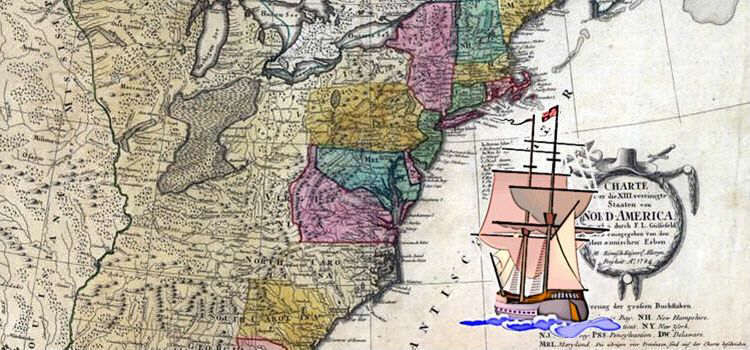
My emigration story begins around 1700 in the Rhineland. Back then, our region belonged to the Holy Roman Empire of the German Nation, a conglomerate of a few big and medium and many small and micro states. The princes decided as absolute rulers over their subjects. In our region, these were the Dukes of Berg and the Archbishops of Cologne.
Duchy of Berg and Electorate of Cologne
Most of the villages on the right side of the Rhine were part of the Duchy of Berg (capital Düsseldorf), which was united with the Duchy of Jülich on the left side of the Rhine. In the end of the 17th Century, when the ruling dynasty in the Palatinate died out, the Duke of Berg became Prince-Elector of the Palatinate. By 1700, Johann Wilhelm ruled, a strict Catholic. Even though his subjects on the Lower Rhine fondly called him “Jan Wellem”, he was an absolutist ruler who tolerated no other confession than the Catholic.
The towns of Königswinter and Ittenbach with the mountains Drachenfels and Wolkenburg on the right bank and large estates on the left bank belonged to the Archbishops of Cologne. They were Prince-Electors since the Middle Ages already. We will refer to them as “Elector-Archbishop”. From 1583 to 1761, the Archbishops came from the House of Wittelsbach from Bavaria. They held court in their residence in Bonn.
According to the Augsburg Peace of 1555, the princes could choose the religion in their lands. In other words: they could freely decide to be either a Catholic or a Lutheran. Their decision was binding for his subjects, they had no freedom of religion. If they did not convert, they were only granted some time to leave the country. Since the Peace of Westphalia of 1648, the Catholic, Lutheran and Calvinist confessions were recognized.
Prosecution
The Anabaptists, however, among them the Mennonites, were persecuted. With their demands for freedom of worship, separation between church and state and rejection of all church authority they were a threat to the authorities. Anabaptists who did not recant could be executed on the sport, without legal proceedings. (Anabaptist mandate, Diet of Speyer, 1529). In the Palatinate, which had suffered a lot during the devastating Thirty Years” War (1618-1848), this was handled in a more tolerant manner. Prince-Elector Karl Ludwig welcomed the Mennonites as hard workers to rebuild his ruined country. Also families from the Seven Mountains had moved to the Palatinate.
Then came the Nine Years’ War (War of the Palatinate Succession, 1688-1697). In his struggle to obtain predominance in Europe, Louis XIV of France repeatedly imposed wars on his neighboring countries. France”s territory should be extended to the Rhine, and for this he set his mercenary armies on the march. Soon wide regions in the west and southwest lay in ruins and much of the population were on the run.
Wars
Louis XIV, who in France had repealed the Edict of Nantes (1598), also wanted to impose Catholicism on the people in the Palatinate. He agreed to the Peace Treaty of Ryswick (1697) only under the condition that the recatholization would not be revoked. The strict Catholic Prince-Elector Johann Wilhelm could not agree more, but it was bad news for many non-Catholics. Although the dukes fought Louis XIV – his sumptuous court life at Versailles impressed them greatly, and who could created his own little Versailles. Most likely, they didn’t think of their subjects whose taxes and hard work financed their courts, their campaigns and reconstructions. We have to consider that most people lived in dire poverty.
In the Palatinate and in neighboring areas, which had terribly suffered from the wars, the ruined land could no longer feed all its people. Bitter hardships and religious persecution made emigration to far way North America an option worth considering, although one knew hardly anything about it. On the other side, England was looking for settlers for its colonies. Many recruiters came to the Middle and Upper Rhine. Formally, emigration was forbidden, yet as Germany back then was fragmented into countless small and micro states, the Princes could hardly stop the recruiters.
Pennsylvania
Pennsylvania was one of the 13 British colonies in North America. It is named after its founder William Penn. Penn, a Quaker who in England was pursued and imprisoned twice, preached religious tolerance and political liberalism. In his Pennsylvania, tolerance, religious freedom, brotherhood and personal freedom were granted to settlers and Indians. He sought a compromise with the Indians, spoke several Indian languages and complied with contracts. Twice he had been in Germany to promote settling in his colony. In 1683, 13 Quaker and Mennonite families from Krefeld around Franz Daniel Pastorius, the “Original 13” sailed on the “Concord” to North America. In Pennsylvania, they founded Germantown, today a part of Philadelphia.
Apart from the often-mentioned Carl Schurz, who comes from the Rhineland, and other historical figures all the people and places, such as the “Merry Dragon Inn” and the “Mirbi Creek Road” in southeastern Pennsylvania are fictional. Any resemblance to persons living or dead is purely coincidental.

Be the first to comment